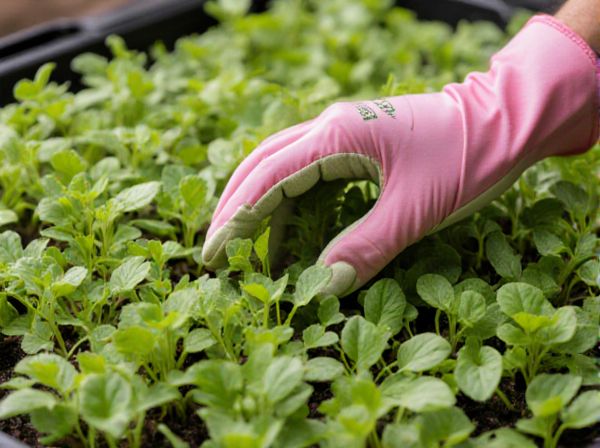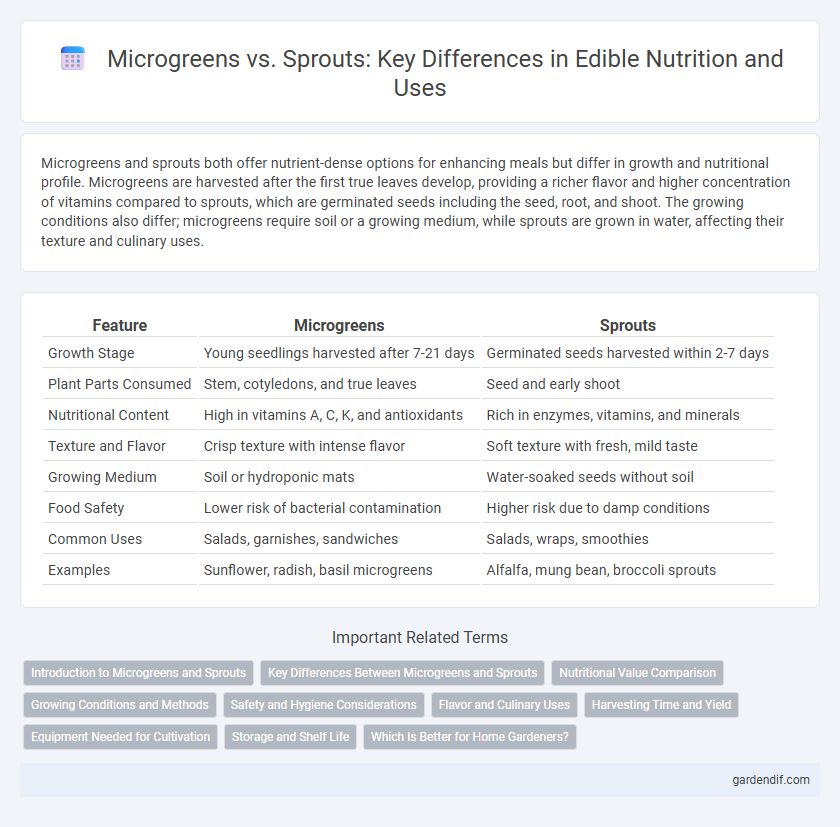
Microgreens vs Sprouts Illustration
Microgreens and sprouts both offer nutrient-dense options for enhancing meals but differ in growth and nutritional profile. Microgreens are harvested after the first true leaves develop, providing a richer flavor and higher concentration of vitamins compared to sprouts, which are germinated seeds including the seed, root, and shoot. The growing conditions also differ; microgreens require soil or a growing medium, while sprouts are grown in water, affecting their texture and culinary uses.
Table of Comparison
| Feature | Microgreens | Sprouts |
|---|---|---|
| Growth Stage | Young seedlings harvested after 7-21 days | Germinated seeds harvested within 2-7 days |
| Plant Parts Consumed | Stem, cotyledons, and true leaves | Seed and early shoot |
| Nutritional Content | High in vitamins A, C, K, and antioxidants | Rich in enzymes, vitamins, and minerals |
| Texture and Flavor | Crisp texture with intense flavor | Soft texture with fresh, mild taste |
| Growing Medium | Soil or hydroponic mats | Water-soaked seeds without soil |
| Food Safety | Lower risk of bacterial contamination | Higher risk due to damp conditions |
| Common Uses | Salads, garnishes, sandwiches | Salads, wraps, smoothies |
| Examples | Sunflower, radish, basil microgreens | Alfalfa, mung bean, broccoli sprouts |
Introduction to Microgreens and Sprouts
Microgreens are young vegetable greens harvested after the cotyledon leaves have developed, typically within 7-21 days of germination. Sprouts are germinated seeds consumed whole, including the root, stem, and seed, usually harvested within 2-7 days. Both microgreens and sprouts are nutrient-dense but differ in growth stage, texture, and culinary uses.
Key Differences Between Microgreens and Sprouts
Microgreens are young vegetable greens harvested after the cotyledon leaves have developed, typically 7-21 days post-germination, whereas sprouts are germinated seeds consumed whole, including the root, seed, and shoot, usually within 2-7 days. Microgreens exhibit higher nutrient density and a more complex flavor profile compared to sprouts, which are more delicate and primarily valued for their crunchy texture. Cultivation methods differ significantly: microgreens require soil or a growing medium with light exposure, while sprouts grow in water without light, influencing their taste and nutritional content.
Nutritional Value Comparison
Microgreens contain higher concentrations of vitamins A, C, and K compared to sprouts, with some studies showing up to 40 times more nutrients per serving. Sprouts, while rich in enzymes and protein, tend to have lower fiber content and may carry a higher risk of bacterial contamination due to their growth environment. Consuming microgreens can provide more potent antioxidants and essential minerals, making them a superior choice for enhancing overall nutritional intake.
Growing Conditions and Methods
Microgreens require soil or a soil substitute and consistent light exposure for 7-21 days to develop vibrant leaves, thriving in well-drained, nutrient-rich growing mediums. Sprouts grow in dark, warm, and humid conditions for 3-7 days, typically submerged or rinsed in water to encourage rapid germination without soil. The controlled environment for sprouts reduces contamination risks, while microgreens benefit from photosynthesis, resulting in higher nutrient density.
Safety and Hygiene Considerations
Microgreens pose lower safety risks than sprouts due to their growing methods involving soil or growth mats, which reduce bacterial contamination compared to sprouts grown in warm, moist conditions ideal for pathogen growth. Proper hygiene practices, including sterilizing seeds and using clean water, are essential to minimize risks in both microgreens and sprouts production. Consuming microgreens after thorough washing and ensuring sprouts come from reputable sources further protects against foodborne illnesses.
Flavor and Culinary Uses
Microgreens offer intense, concentrated flavors like peppery arugula or tangy radish, making them ideal for garnishing salads, sandwiches, and gourmet dishes. Sprouts have a mild, fresh taste with a crunchy texture, commonly used in salads, wraps, and stir-fries for added crispness. Both microgreens and sprouts enhance culinary presentations and nutritional profiles but differ significantly in flavor intensity and texture applications.
Harvesting Time and Yield
Microgreens are typically harvested between 7 to 21 days after germination, yielding a higher mass of nutrient-rich shoots compared to sprouts, which are harvested much earlier, usually within 3 to 7 days, focusing primarily on the seed and root. Microgreens provide a more substantial yield per tray due to their larger size and developed leaves, while sprouts offer a faster harvest but with a lower overall biomass. The extended growth period of microgreens allows for greater flavor complexity and nutrient density, making them ideal for fresh culinary use.
Equipment Needed for Cultivation
Microgreens cultivation requires tools such as trays with drainage holes, quality potting soil or growing mats, and regular misting equipment to ensure proper moisture levels. Sprouts need minimal equipment, typically a jar or sprouting tray with a mesh lid to allow air circulation and easy rinsing multiple times a day. Both methods benefit from a controlled environment with adequate light and temperature, but microgreens demand more space and substrates for healthy root development.
Storage and Shelf Life
Microgreens typically have a longer shelf life than sprouts, lasting up to 10 days when stored properly in a refrigerator at 32-40degF (0-4degC). Sprouts require more careful handling due to their high moisture content and delicate structure, generally lasting only 3-5 days under similar refrigeration conditions. Proper storage in breathable containers with minimal moisture exposure helps maintain freshness and reduces the risk of bacterial growth in both microgreens and sprouts.
Which Is Better for Home Gardeners?
Microgreens offer home gardeners a nutrient-dense option with higher concentrations of vitamins and minerals compared to sprouts, making them ideal for boosting dietary health. Sprouts grow faster and require minimal space and equipment, appealing to beginners seeking quick, fresh additions to meals. Choosing between microgreens and sprouts depends on available space, growth time, and specific nutritional goals in home gardening.
Microgreens vs Sprouts Infographic

 gardendif.com
gardendif.com